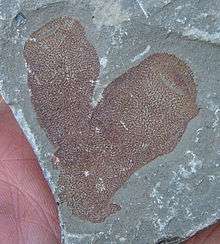Hazeliidae
| Hazeliidae Temporal range: Chengjiang–Middle Ordovician[1] | |
|---|---|
 | |
| A specimen of Hazelia at the Mount Stephen Trilobite Beds | |
| Scientific classification | |
| Kingdom: | Animalia |
| Phylum: | "Porifera" |
| Class: | Demospongiae |
| Order: | Monaxonida |
| Family: | Hazeliidae Walcott, 1920 |
| Species | |
| |
The Hazeliidae are a family of spicular Cambrian demosponges known from the Burgess Shale, the Marjum Formation of Utah,[3] and possibly Chengjiang.[1] It was described by Charles Walcott in 1920.
References
- 1 2 Botting, J. (2007). "'Cambrian' demosponges in the Ordovician of Morocco: Insights into the early evolutionary history of sponges". Geobios. 40 (6): 737–748. doi:10.1016/j.geobios.2007.02.006.
- ↑ Rigby, J. K. (1986). "Sponges of the Burgess shale (Middle Cambrian), British Columbia". Palaeontographica Canadiana (2).
- ↑ J. Keith Rigby; Lloyd F. Gunther; Freida Gunther (1997). "The First Occurrence of the Burgess Shale Demosponge Hazelia palmata Walcott, 1920, in the Cambrian of Utah". Journal of Paleontology. Paleontological Society. 71 (6): 994–997. doi:10.2307/1306598 (inactive 2015-01-09). JSTOR 1306598.
This article is issued from Wikipedia - version of the 10/29/2016. The text is available under the Creative Commons Attribution/Share Alike but additional terms may apply for the media files.